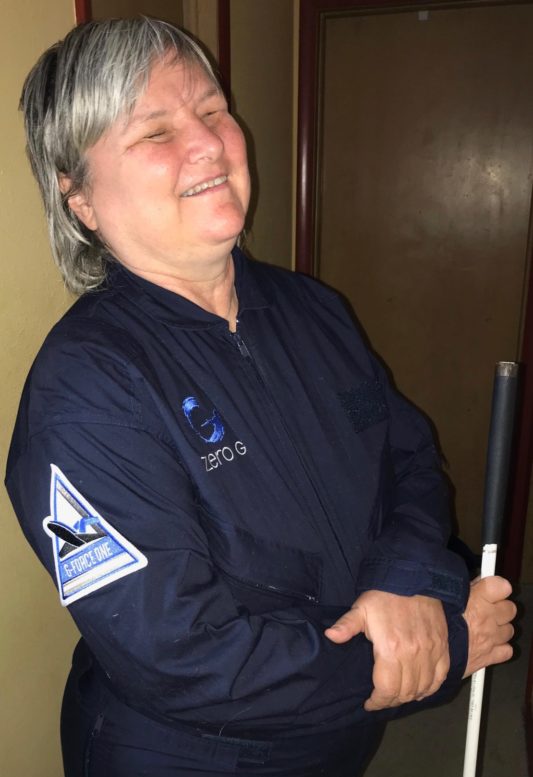By DAVID DUPONT
BG Independent News
Reached by telephone at her hotel room in California, Sheri Wells-Jensen is laughing.
She explains she woke up from a dream a half-hour ago. In the dream she was floating. She had been laughing since then.
Wells-Jensen is still coming off the highs of her flight into zero gravity as an AstroAccess Ambassador, one of a dozen scholars, scientists and activists intent on opening up space to those, like themselves, with disabilities. Wells-Jensen was one of several ambassadors who is blind.
[READ RELATED STORY: Sheri Wells-Jensen embarks on mission to break barriers in space travel]
On Sunday, they flew on a modified 747 jet provided by Zero Gravity Corporation and made 15 ascents and then 15 steep descents that created Zero gravity, lunar gravity or Martian gravity.
“It was terrifying and marvelous,” the BGSU linguistics professor and space enthusiast said. “Take all the emotions in the human head and line them all up. That’s what we did this weekend.”
She particularly liked lunar gravity. “I loved the moon so much. You’re so strong and you can leap. But you shouldn’t leap because you’ll hit your head on the cabin. It’s true.”
That flight, though, was just the beginning. “We did a thing,” she said. “And nobody threw up or fell out the side door of the plane. We went up and down and up and down and nobody got hurt.”
Just achieving that was “an incredible success.”
But once the buzz fades, and everyone “figures out where up and down is,” they’ll set about figuring out what’s next.
As the official giver of homework, Wells-Jensen has asked all the ambassadors to write down in as precise and candid detail as possible everything about the mission. That’s not to share, but just a preserve as much as possible. Then they will gather to discuss what they learned.
Zero gravity was not at all like Wells-Jensen expected. Floating does not describe the sensation, she said. When someone is floating in water, they can feel the water. And it’s not like riding a roller coaster.
In zero gravity, she was settled, and then she was separated from the mat. “How did that air slip between me and the place where I was just sitting? How did that that happen?”
And she reacted out of instinct, an instinct that has always served her well. Her hands extended very quickly to get her bearings. In zero gravity when she did that, she began to spin.
“You become this graceless ball of spinning human,” Wells-Jensen said. “You come to the part of the show where I don’t know if I’m on the wall, the ceiling or the floor.”
And when the announcement is made that they will be coming out of zero gravity, that makes a difference. If it’s the floor, everything will be fine. If it’s the wall, she’ll have a bit of a drop. If it’s the ceiling, seven feet above the mats, “I’ll have a pancake experience.”
On a number of occasions the Zero G crew just took hold of her and guided her safely to the floor.
All the things the blind group set up as being useful were “100,000 percent flat fails.”
The idea was to have sound beacons coming from the floor. “We are really bad at hearing sound beacons in the 90-plus decibel roar of jet engines.” She heard none of them.
They did find that the braille display used to write did work. And Wells-Jensen figured out how to anchor herself with one hand and write with a stylus and slate with the other. She’s most likely the only person who has ever done that in zero gravity. “I don’t know what it’s worth but it’s funny.”
Those with mobility disabilities did make discoveries about what would help them in zero gravity. Extra straps to hold onto, ropes to pull themselves up, and a cane-like device to help maneuver.
The deaf ambassadors learned something about the challenges of using sign language in zero gravity. “Every word that you utter, that you sign, knocks your body into a new position,” Wells-Jensen said.
“We have not processed any of this data yet because we’re just still vibrating.”
That analysis will help determine the next step.
“I have ideas about the limits of orientation you can achieve in a hellishly loud environment that changes where your feet go every 20 seconds,” Wells-Jensen said.
The goal is not to figure out how to make going to space a perfectly secure experience for someone who is totally blind.
“Maybe the most practical solution to keep a blind person from splattering themselves in zero g is to have someone with them,” she said.
And maybe “when we go on a suborbital flight it won’t be as hellishly loud or as chaotic with all those people bouncing around.”
But, she said, “is this a problem we need to solve or a difficulty we need to move past?”
Some problems may not be worth the huge investment to solve. What is worth the investment is making suborbital and orbital flight safe for everyone.

